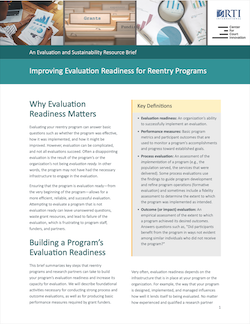Improving Evaluation Readiness for Reentry Programs
 This resource brief from RTI International and the Center for Court Innovation summarizes key steps that reentry practitioners and their research partners can take to build their program’s evaluation readiness and increase capacity for evaluation. The brief describes foundational activities necessary for conducting strong process and outcome evaluations, as well as for producing basic performance measures required by grant funders.
This resource brief from RTI International and the Center for Court Innovation summarizes key steps that reentry practitioners and their research partners can take to build their program’s evaluation readiness and increase capacity for evaluation. The brief describes foundational activities necessary for conducting strong process and outcome evaluations, as well as for producing basic performance measures required by grant funders.
View the Resource Brief (PDF)
Related Resource:



